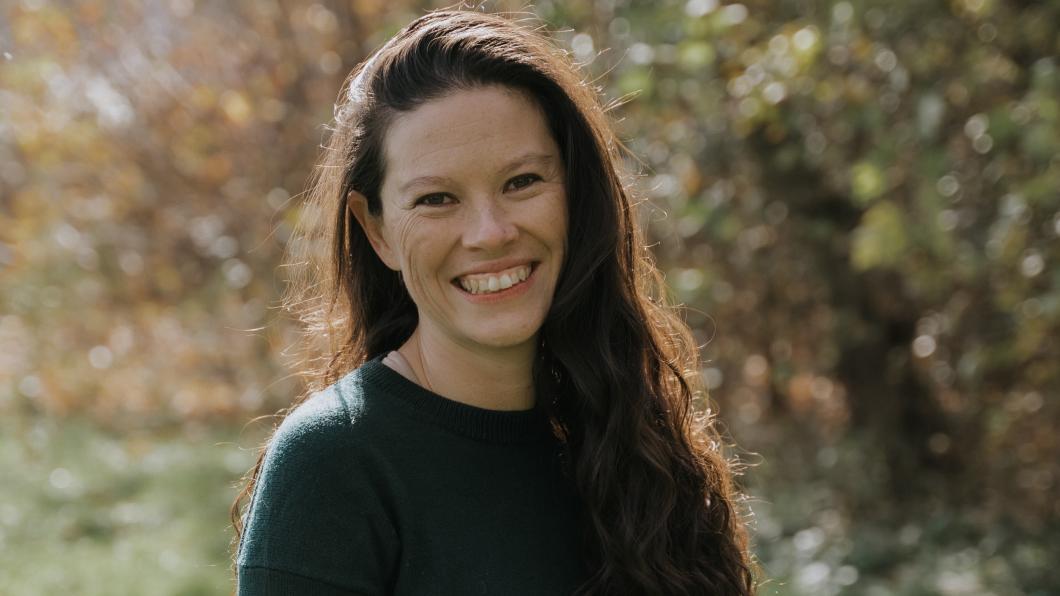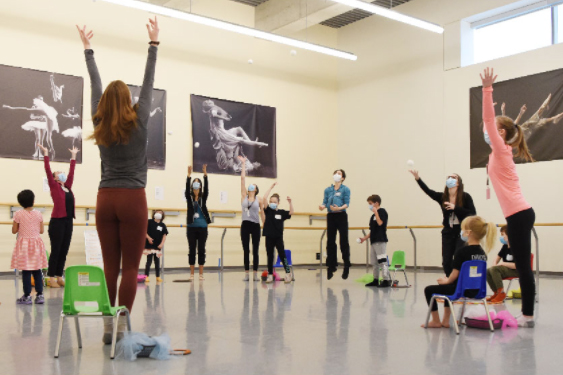
Amanda's mission is to ensure every child thrives in daycare
By Louise Kinross
Amanda Musto is an occupational therapist at Holland Bloorview who works with child-care centres across Toronto to make sure all children thrive in daycare. She's part of the city's Every Child Belongs program. More recently Amanda consulted with the National Ballet of Canada to develop an adapted dance program for children with disabilities. We spoke about how Amanda got into her field and the approach she brings to her work.
BLOOM: What is a typical day like for you?
Amanda Musto: Like everyone else, my typical day is very different from what it was pre-pandemic. Before I'd drive all over Toronto to go into daycares. I would do an observation and meet with the family, the daycare staff and the resource consultant and we would collaborate together to come up with strategies. Did you know there's even a child care on Toronto Island? Now I'm completely virtual. In some ways that's been wonderful as more parents can attend meetings.
BLOOM: What kind of strategies might you be working on?
Amanda Musto: I'm a Jill of all trades, master of none. A referral could be for feeding, equipment, or for sensory, fine-motor or gross-motor skills. You have to be prepared for everything and every environment is different.
The majority of my consultations are around sensory processing and self-regulation. It's usually the first time a child has been a part of group care, and often my role is to educate adults on why children are engaging in certain activities. For example, a child might be jumping down from things or climbing things because they have this energy and they want to get it out. That's not necessarily a bad thing, but we need to redirect it to something more functional. So perhaps they can march on the spot or they can do 'helper' tasks, like pushing in chairs or moving bins or setting the table.
Most of the children I see haven't been diagnosed yet. Many will be assessed and some will receive a diagnosis and others won't.
BLOOM: What's the greatest challenge of your job?
Amanda Musto: Sometimes going into the community can be challenging because we have such a progressive and inclusive environment at Holland Bloorview. We want everyone to be where we are and it can be frustrating if they're not. But I remind myself that everyone is on a journey and we need to meet them where they are. I was part of the first cohort at Holland Bloorview to graduate from solution-focused coaching, so I come with a strengths-based approach. I don't see myself as the expert coming in to tell them what they're doing wrong.
I see myself as collaborating. I want to acknowledge what they're already doing really well, and then build off that to see what they can do more of. I want teachers to feel empowered and that they're coming from a place of care, even though they might be operating from an outdated model.
BLOOM: What are the greatest joys?
Amanda Musto: Everything. I love everything about my job. I love the population I work with. I love early learning and development. I love meeting parents at the beginning of their journey. I remind parents to see all of the strengths and beauty and personality of their child in a world where people might be highlighting their deficits.
I love working in child care because early childhood educators are the most caring, loving, willing to learn and motivated people. When I'm able to go into the classrooms, I love the energy of the children and I could be there all day.
BLOOM: How did you get into occupational therapy?
Amanda Musto: It's a funny story. I really wanted to be a child psychiatrist. That was my hope when I went to the University of Toronto for my undergrad. I wanted to get some volunteer experience, so I volunteered with what was then the Hincks Dellcrest Centre and I got paired up with a jumpstart program in the St. Jamestown area. It was an after-school program and it just so happened that there were two occupational therapy students there.
I had never heard of occupational therapy before. It never touched my life. I was so intrigued by that profession, and I talked to them about it and why they chose it. I really loved the functional nature of it. It empowers whoever you're working with to participate in their life to the best of their ability and in ways that are important to them. It's really client-centred and it really spoke to me.
BLOOM: What emotions come with your job?
Amanda Musto: Compassion is huge. It's understanding where everyone is coming from, incorporating their lived experience, and working together to find a way forward that feels right for everyone.
BLOOM: How do you manage stress?
Amanda Musto: I used to operate under the model that I'm the expert, and I'm coming in and telling them what to do. That puts a lot of pressure on you as a clinician—to always know the answer and to be right all the time.
I don't operate that way anymore. Instead, I've found that working with transparency and vulnerability makes for a true collaboration. So I may be an expert in something like feeding, but the teachers are the experts of their classrooms and the parents are the experts of their child and we'll find a way that will work for everyone. That reduces my stress, because I don't have to be perfect.
When I begin with highlighting all of their strengths and resources and what's going well, I can empower people to feel like they can do it. However, if I come in and say 'You need to do this, this, and this,' they may feel defeated.
BLOOM: How did you get involved in developing an adapted dance class with Canada's National Ballet School?
Amanda Musto: I'm such a lucky person. I'm open to opportunities, and amazing opportunities land in my lap. I actually went to Canada's National Ballet School when I was little. I was part of the full-time program. I'm from London, Ontario and I lived in residence there in Toronto from Grade 5 to Grade 8. Dance has always been a part of my life.
I was on the varsity dance team at U of T. When I moved to Toronto it so happened a high-school friend of mine was teaching an inclusive ballet class called Ballerina Dreams, and they were looking for an occupational therapist. I took that over for four years. When I received an e-mail from Andrea Macdonald about how the National Ballet had reached out to Holland Bloorview and wanted to create an inclusive environment I said: 'Oh my gosh, this is an opportunity made for me."
BLOOM: Who is the adapted program targeted to?
Amanda Musto: The beauty of this program is there's no inclusion or exclusion criteria in terms of disability, other than age. It can be any child between the ages of six and nine, but we've even waived that in some cases when parents have reached out. There's a huge mix of children and abilities and disabilities.
We ran a pilot last fall and we just launched the 12-week program in February. There are two streams. Creative 1 would be slower paced and we train one-to-one volunteers to provide support. Creative 2 is faster-paced and has two children to every one volunteer. The plan is to expand the program to meet the needs of registration by adding more adaptive classes, while also exploring an option for dancers who are interested to integrate into the recreational stream programming.
BLOOM: What kind of dance do the students learn?
Amanda Musto: It's creative movement, the joy of movement. So they're learning beats and rhythms and understanding phrasing of music. They explore and emulate the quality of the music: Is it sharp or soft or fluid or stationary? We explore emotions and what that might look like through movement. It's not a traditional, defined curriculum like ballet or jazz. It focuses on the expression and joy of movement.
BLOOM: How were you involved in adapting the program for children with disabilities?
Amanda Musto: The big thing was setting up the environment to support success. So making sure a child with physical disabilities has trained volunteers who are comfortable with assisting. A lot of our children have cognitive or sensory processing differences, so making sure they have their own designated space, having visuals in terms of markers on the ground, and using visuals when we're transitioning to different activities. We have fidgets that kids can use to help them while they're sitting and receiving instruction, and noise-cancelling headphones.
The class takes place in a huge, beautiful studio. Each class has a maximum of 12 children. Before I even got on board, they created an accessible washroom on the level of the studio and made the entranceway accessible. Canada’s National Ballet School is very motivated and committed to creating spaces for children of all abilities to foster their love of dance.
To learn more about the new adapted dance classes (see image below) at Canada's National Ballet School, click here. The classes are subsidized and there is very generous financial support for families who need it. Like this interview? Sign up for our monthly e-letter. You'll get family stories and expert advice on raising children with disabilities; interviews with activists, clinicians and researchers; and disability news: https://bit.ly/3IIK5Qo.
